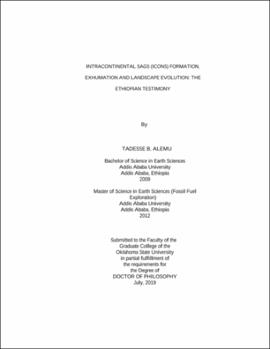| dc.contributor.advisor | Abdelsalam, Mohamed | |
| dc.contributor.author | Alemu, Tadesse B. | |
| dc.date.accessioned | 2021-04-06T16:06:37Z | |
| dc.date.available | 2021-04-06T16:06:37Z | |
| dc.date.issued | 2019-07 | |
| dc.identifier.uri | https://hdl.handle.net/11244/329099 | |
| dc.description.abstract | The study of the Mekele Sedimentary Basin (MSB) in Ethiopia revealed geological and geophysical features that can be interpreted as resembling an ICONS (IntraCONtinental Sag). ICONS are groups of sedimentary basins that develop within the interior of continental plates. The MSB is filled with ~2 km thick mixed clastic-carbonate sediments ranging in age from Ordovician/Silurian (440 to 460 Ma) to middle Cretaceous (100 to 120 Ma). This study used field, remote sensing and satellite gravity data. Gravity data is used to conduct spectral analysis, forward and inverse modelling to outline the geometry of the basin and lithospheric-scale-structures across the region. Owing to its location over the juvenile Neoproterozoic accretionary Pan-African terranes, cooling and thickening of the basement beneath the basin is proposed as an alternative basin-forming mechanism. The MSB is unique in that the sedimentary formations and geological structures associated with ICONS are almost completely exposed on the surface due to a combination of tectono-magmatic and surface fluvial incision processes. Accordingly, the combined analysis of morphometric parameters and geophysical data to evaluate the regional geodynamic link between tectono-magmatic processes and landscape evolution during Cenozoic was carried out. Broad patterns of topographic variation along the strike of the western escarpment of the Afar Depression bordering the MSB reflect general properties of lithospheric heterogeneity. In the north and central region, the escarpment is underlain by a highly extended and almost tapered crust whereas in the south the highest escarpments overlie a thickened possibly underplated crust. These features partially correspond with the along-strike variation in geomorphic features. However, it appears that the first-order landscape development is primarily controlled by a regional process. Further, the incision history of the northwestern plateau drainage system was examined based on a case study from the Blue Nile Gorge, where ~1500 m Mesozoic section is exposed along the Blue Nile River. Unlike the MSB, the Blue Nile Basin is covered with Oligocene volcanic rocks, and hence, provides a good constraint on the incision history. Here, using geomorphic proxies from field, remote sensing, and published rate of incision through time curve stratigraphic control is evaluated. Despite vast variability, the study found limited influence of lithology. | |
| dc.format | application/pdf | |
| dc.language | en_US | |
| dc.rights | Copyright is held by the author who has granted the Oklahoma State University Library the non-exclusive right to share this material in its institutional repository. Contact Digital Library Services at lib-dls@okstate.edu or 405-744-9161 for the permission policy on the use, reproduction or distribution of this material. | |
| dc.title | IntraCONtinental Sags (ICONS) formation, exhumation and landscape evolution: The Ethiopian testimony | |
| dc.contributor.committeeMember | Atekwana, Estella | |
| dc.contributor.committeeMember | Pashin, Jack | |
| dc.contributor.committeeMember | Nygaard, Runar | |
| osu.filename | Alemu_okstate_0664D_16387.pdf | |
| osu.accesstype | Open Access | |
| dc.type.genre | Dissertation | |
| dc.type.material | Text | |
| dc.subject.keywords | along-strike topographic variation | |
| dc.subject.keywords | gorge of the nile | |
| dc.subject.keywords | intracontinental sag (icons) | |
| dc.subject.keywords | lithospheric cooling and thickening | |
| dc.subject.keywords | mekele sedimentary basin | |
| dc.subject.keywords | morpho-tectonic analysis | |
| thesis.degree.discipline | Geology | |
| thesis.degree.grantor | Oklahoma State University | |
